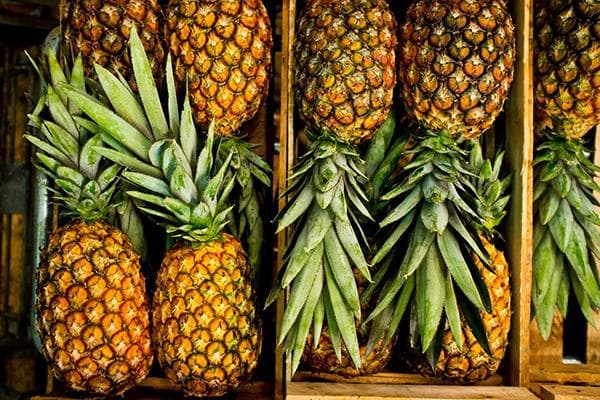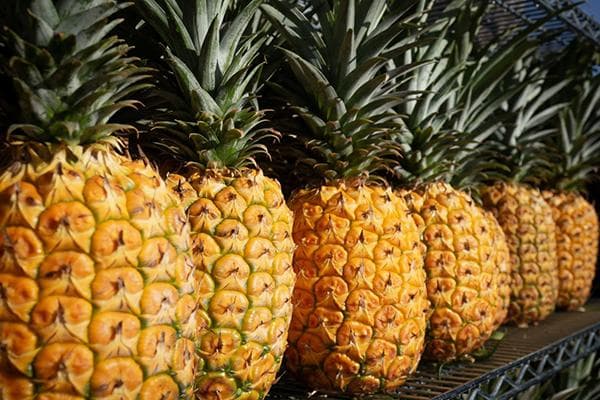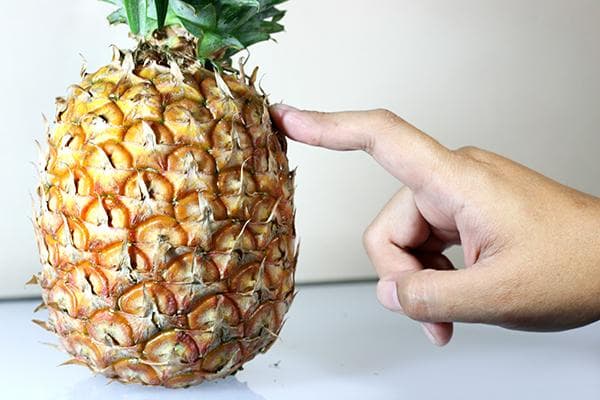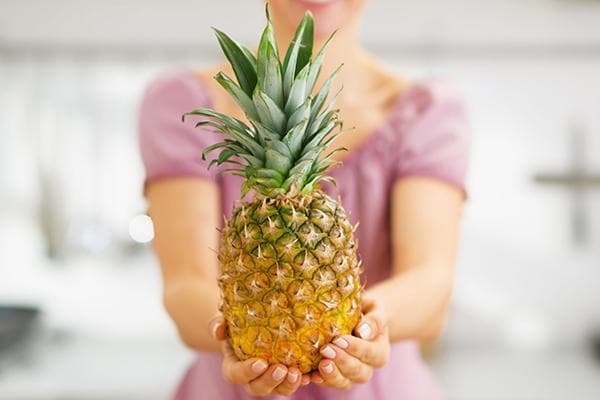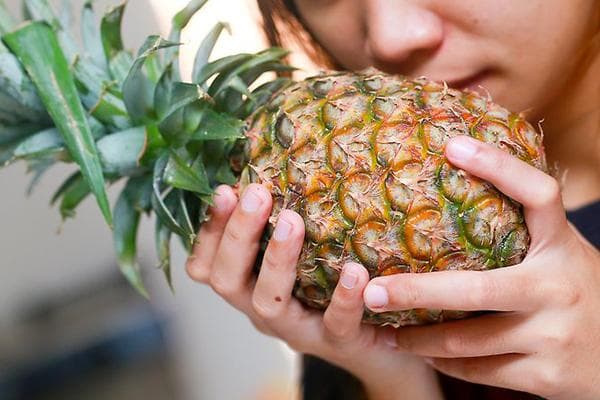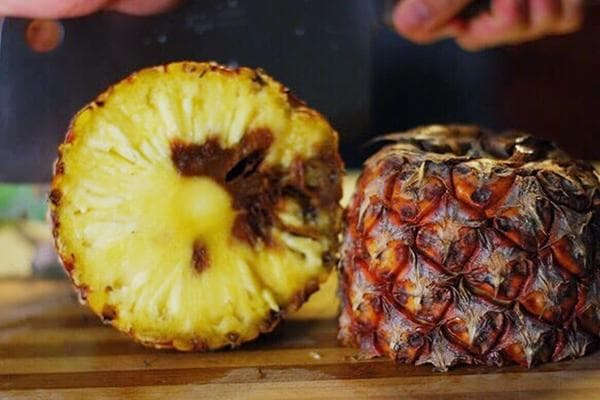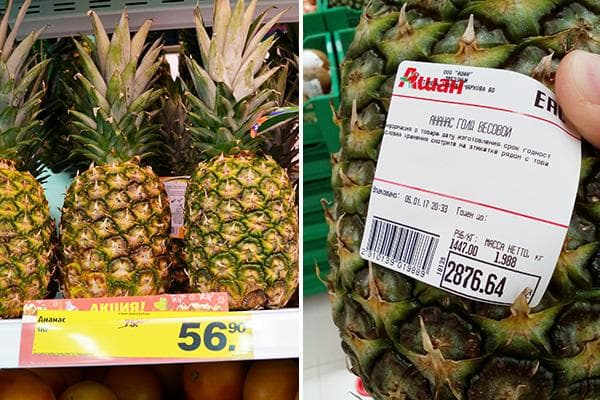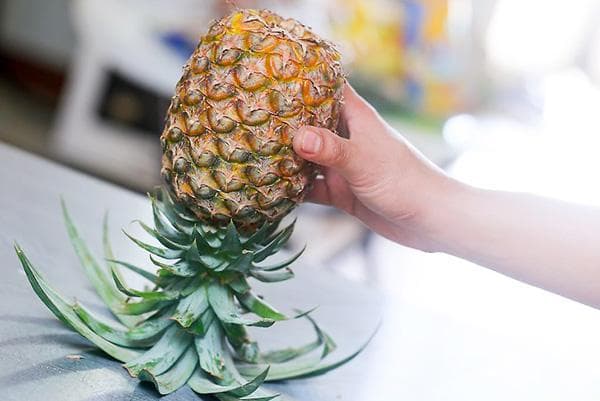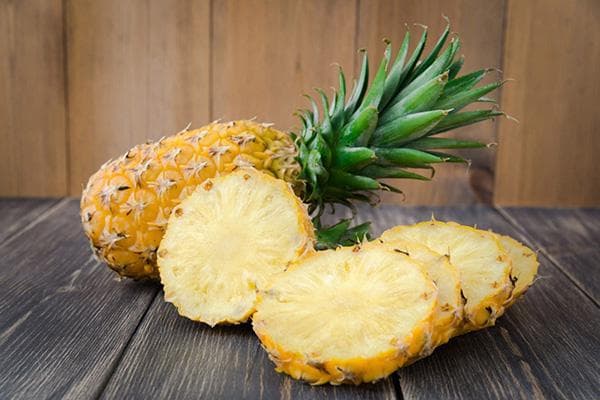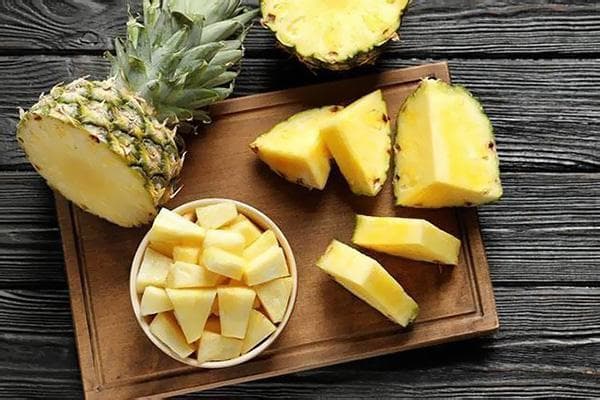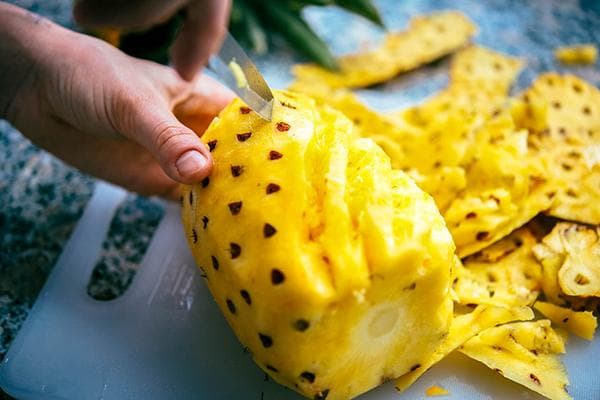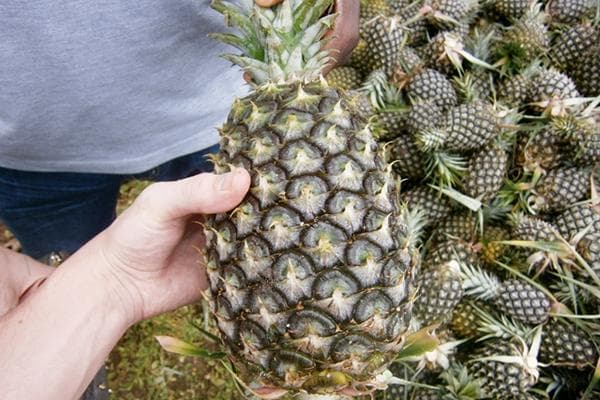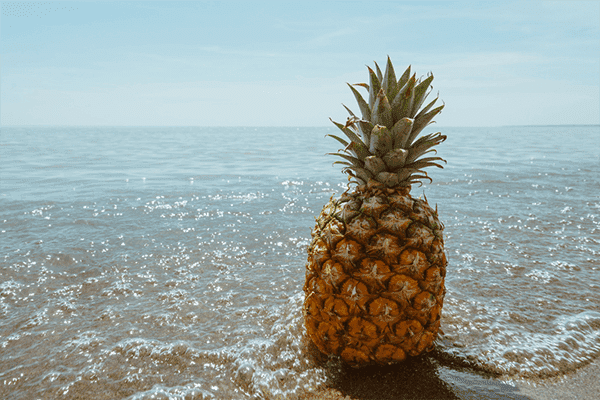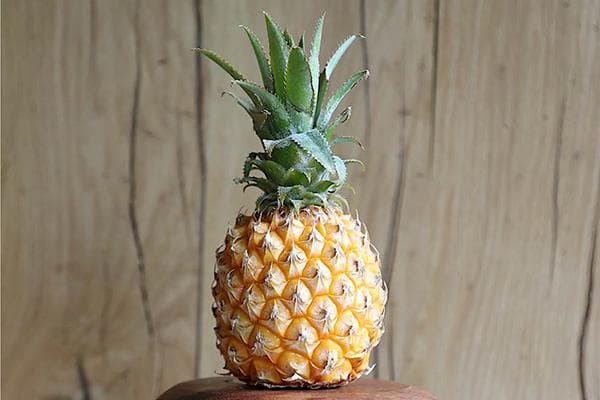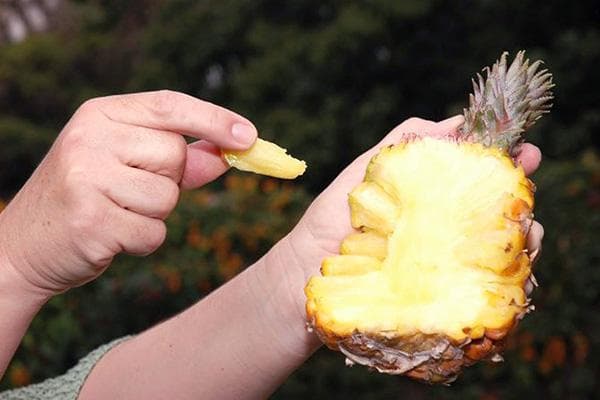How to choose a fresh, ripe and tasty pineapple: a New Year's cheat sheet for those who are going to the store
Content:
Today, few buyers know how to choose a pineapple. The imagination pictures a juicy and sweet fruit that smells like the tropics. However, expectations do not always coincide with reality. Since exotic fruits are brought from afar, low-quality specimens often end up on the shelves: unripe or overripe, dried out or rotten from the inside. But such pleasure is not cheap. We invite you to find out what signs you can use to determine the ripeness and quality of pineapple in the store.
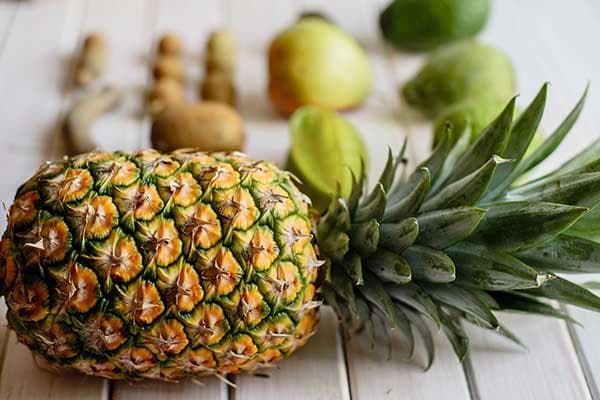
How to determine the ripeness of a pineapple: step-by-step instructions
Ripe pineapple has a pleasant sweet taste with a slight sourness. It contains a huge amount of vitamins and enzymes. This fruit not only brings pleasure, but also helps you lose weight.But an unripe fruit is too sour, ties the tongue and “bites” the corners of the mouth, causing indigestion. There is also little good in overripe fruit: it is absolutely tasteless and practically devoid of vitamins.
Fortunately, you can determine the ripeness of a pineapple by its appearance, weight and aroma. The instructions below will help you avoid making mistakes when purchasing.
Step 1. Inspect the plume (top)
A ripe pineapple has a dark green plume, and the tips of the shoots are slightly dried out. If the color is too bright, it means the fruit is not yet ripe. The tail of stale fruits is yellow-brown, dry, and almost crumbles in the hands.
Try to gently twist the plume (just don’t tear it off). If it works, it means the pineapple is ripe. Unripe fruits have a tightly held tail because they are picked while still green.
But the “pomp” of the Sultan does not mean anything. In some varieties it is wide, while in others it is small and prickly.
Step 2. Assess the appearance of the peel
A delicious pineapple has a golden, yellow-brown or yellow-green peel. The stripes between the scales are brownish. There are no large dark spots on the peel. The tails on the scales are dry and break off easily. The stalk is also dry, without signs of rot or mold.
An unripe fruit usually has a brighter green rind. The tails on the scales do not break off, but bend. An overripe fruit gives off a brown tint to the skin.
Step 3. Press down on the scales
Hard like coconut? This means the pineapple is still green inside. In a ripe fruit, the scales respond to pressure and seem elastic to the touch. But if dents remain on the peel after pressing, it means that the fruit has already begun to rot.
Step 4. Hold the fruit in your hands
A good pineapple will be heavy. As well as unripe.But if the fruit is suspiciously light, then its pulp is too dry. Perhaps the correct storage and transportation conditions were not met, or the fruit lay in the store for too long.
Step 5: Tap the Pineapple
The same principle applies here as when choosing a watermelon. A “dull” sound indicates the ripeness of the fruit, and an “empty” sound indicates drying of the pulp. Unripe pineapples sound loud when tapped.
Step 6: Inhale the Aroma
Fresh pineapple has a light tropical trail with caramel notes. But if the smell “hits” your nose, perhaps the fruit is already overripe. An unripe fruit has almost no smell.
What are the signs of a spoiled pineapple?
If an overripe fruit can at least theoretically be eaten, then a spoiled one cannot.
Never buy fruit in the store if you notice the following signs:
- The peel is dull and has a grayish tint.
- The top falls off.
- The smell is pungent, reeks of alcohol or acid.
- There are fragments of mold on the stalk, and whitish specks, cracks or smudges in the stripes between the scales.
- Some areas of the peel are damaged when pressed.
Spoiled pineapple can cause food poisoning. Even if you cut out the rotten areas, you will not protect your body 100%, since bacteria and fungi have already spread throughout the pulp.
How does price affect the quality of pineapple?
Why do some pineapples in the store cost much more than others, although there is no difference in appearance? It's a matter of transportation. Exotic fruits are brought from afar in one of two ways:
- on the ship;
- by plane.
In the first case, the fruits are picked from the plantation while still green. They ripen already in the hold of the ship. True, not completely.During transportation, the loss of some vitamins is inevitable; the fruit may dry out or rot.
Ripe fruits arrive at the store by plane in 1–2 days. They have an excellent taste, the flesh is fresh and juicy. However, with this method of transportation the price is higher. Only the buyer decides which pineapple to choose: expensive and fresh or budget, but with flaws in taste.
How to ripen pineapple at home?
Many vegetables and fruits emit ethylene gas during storage, which accelerates ripening. To allow pineapple to ripen, you can follow these steps:
- Place the fruit in a paper bag and leave it at room temperature for 3–5 days.
- Turn the fruit upside down and leave it in that position (for example, sandwich it between a wall and a stool). Then sugars and organic acids, which are located mainly in the lower part of the pineapple, will be smoothly distributed throughout the entire pulp. This will lead to an improvement in the taste of the fruit.
Unfortunately, pineapples do not emit as much ethylene as, for example, bananas or mangoes. Therefore, if you bought a completely green fruit, you are unlikely to wait for it to fully ripen.
How to properly store pineapple?
Unpeeled pineapple should not be stored in the refrigerator. In the cold, it instantly loses its bright taste and tropical aroma, and the flesh becomes watery. It is better to store the fruit at room temperature, for example in the kitchen on the table. A ripe pineapple will last for 3-4 days, and an unripe one – up to 1 week.
Store the slices in the refrigerator for up to 2 days. They can be placed on a plate and wrapped in cling film or placed in a plastic container.
Freezing will help preserve pineapple for a long time (up to 2-3 months).Peel the fruit and cut into small slices. Place them on a flat dish in one layer and place them in the freezer for half an hour. Then pack the frozen pieces into containers. Place the fruit back into the freezer.
Which pineapples are the most delicious?
Today you can find dozens of varieties of pineapples on sale, which differ in price and taste. In most cases, only the country of origin is indicated on the label, but sometimes the specific variety is indicated. If you want to learn how to choose delicious pineapples correctly, follow the descriptions below.
Brazilian
Classics of the genre. Botanical name: Ananas comosus. It is Brazilian pineapples that are familiar to many since childhood, as they have long been supplied to the markets of Russia and other CIS countries.
They are large in size, tall and fluffy plume with smooth feathers, and a hard core. They have a classic sweet taste with a slight sourness. Unripe fruits cause an unpleasant tingling sensation on the tongue.
Ananas comosus is now widely grown not only in Brazil, but also in the Hawaiian Islands.
Thai
Thailand produces some of the most delicious pineapples in the world. They are very sweet, with a strong caramel-tropical trail. The taste is a bit like canned ones. So juicy that they literally melt in your mouth.
Thai pineapples are much smaller in size than Brazilian ones, but they are also heavy. The peel and top are prickly.
Varieties of the Cayenne group
These fruits are also often supplied to the Russian market. Similar to Brazilian ones. They have an average weight of 1.5–3 kg.
The taste is sweet and sour, the flesh is dense. They are susceptible to spoilage due to various diseases and pests, so the risk of buying a tasteless fruit is quite high.Cayenne varieties are brought from South Africa, Kenya, Cuba, Puerto Rico, India, and Hawaii.
Spanish
One of the largest pineapples. The peel is smooth to the touch, and the plume is high. In cross section the fruits look almost square.
The pulp is light in color, sour and firm, with a lot of fiber. But Spanish pineapples tolerate transportation well, so you will rarely see spoiled specimens on the shelves.
Varieties of the “Royal” group
Small pineapples weighing up to 1.5 kg with very sweet dark yellow pulp and rich aroma. They are mainly grown in South Africa and Australia.
One of the most interesting varieties is the Mauritius pineapple. It has a conical shape, deep-set eyes and a bushy tail. It doesn't spoil for a long time. The pulp is juicy, sweet, golden yellow in color. Mauritius contains many carotenoids, which are beneficial for vision and skin.
Varieties of the Abacaxi group
These fruits are medium or large in size (1–2.5 kg), with very juicy, almost white pulp. Valued for their sweet taste and low fiber content. The varieties of the Abacaxi group are mainly grown in South American countries.
Thus, the following instructions will help you find the most delicious fruit in the store. You can easily determine ripeness by the appearance of the peel and top, weight and smell. Don't go for cheap. If the fruit is suspiciously cheap, it may have been picked green and a long time ago. Buy fresh pineapple, because it will charge your body with healthy vitamins and delight you with its excellent taste.
